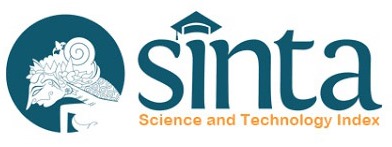Pemanfaatan Tepung Rumput Laut Gracilaria sp. pada Tempe sebagai Alternatif Pangan Sumber Yodium
Abstract
Tempe merupakan produk pangan bergizi tinggi yang digemari dan diterima oleh masyarakat luas, tetapi umumnya memiliki kadar yodium yang rendah. Rumput laut yang kandungan yodiumnya cukup tinggi dapat digunakan sebagai bahan fortifikasi yodium pada makanan. Penambahan rumput laut pada tempe diharapkan dapat menjadi alternatif pangan sumber yodium untuk menanggulangi masalah GAKY (Gangguan Akibat Kekurangan Yodium). Tujuan penelitian ini adalah untuk mengetahui pengaruh penambahan tepung rumput laut Gracilaria sp. terhadap kadar yodium pada tempe serta mengetahui karakteristik yang dihasilkan. Perlakuan yang dilakukan adalah perbandingan kedelai dan tepung rumput laut 100:0; 97,5:2,5; 95:5; 92,5:7,5; dan 90:10. Perbandingan kedelai dan tepung rumput laut 92,5:7,5 merupakan komposisi terbaik yang menghasilkan tempe dengan kadar yodium 0,26 mg/g; nilai sensoris hedonik rata-rata 5 (agak suka), serta 100 gram tempe tersebut memenuhi 17,47% angka kecukupan gizi (AKG) yodium orang dewasa per hari. Studi ini menunjukkan bahwa tempe tersebut dapat digolongkan sebagai pangan sumber yodium karena telah memenuhi 15% AKG orang dewasa.
ABSTRACT
Tempeh is a highly nutritious food that is popular and accepted by diverse community groups, but has low iodine levels. Seaweed, with a high iodine content can be used as a fortification ingredient to increase the iodine levels of the foods. The addition of seaweed in tempeh is expected to be used as an alternative food source of iodine contents to overcome the IDD (Iodine Deficiency Disorders) problem. This study aimed to determine the effect of the addition of Gracilaria sp. seaweed flour to iodine levels in tempeh and to determine the characteristic of the product. The treatments were 5 (five) compositions of soybean and seaweed flour at ratio of (100:0), (97.5:2.5), (95:5), (92.5:7.5), and (90:10). The composition of soybean and seaweed flour at ratio of 92.5:7.5 was the best composition that produces tempeh with an iodine content of 0.26 mg/g; hedonic sensory test results on average 5 (somewhat like) and 100 g of tempeh met 17.47% of the daily iodine requirements for the adults. This study showed that tempeh can be considered as an alternative food source of iodine content as it contributed to 15% of adult’s daily nutritional adequacy.
Keywords
Full Text:
PDFDOI: https://doi.org/10.15578/jpbkp.v16i1.689
Refbacks
- There are currently no refbacks.
JPBKP adalah Jurnal Ilmiah yang terindeks :
ISSN : 1907-9133(print), ISSN : 2406-9264(online)
This work is licensed under a Creative Commons Attribution-NonCommercial-ShareAlike 4.0 International License.








